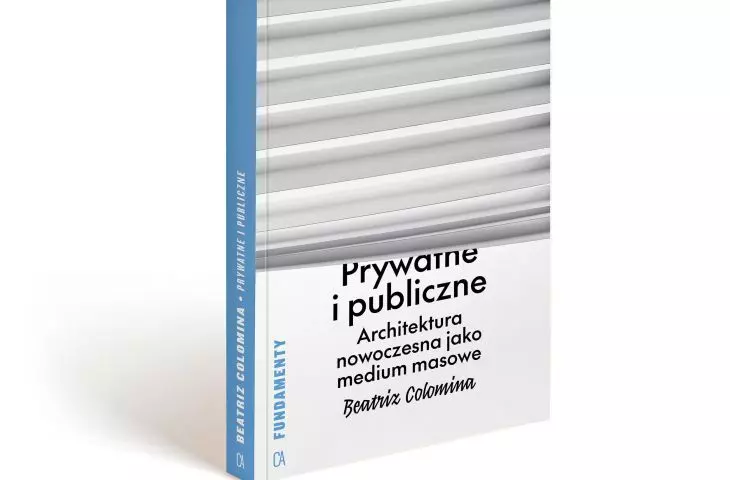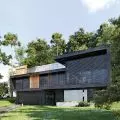The review is from A&B issue 7-8|23
Le Corbusier and Adolf Loos great architects were. Their designs and realizations are icons of 20th-century architecture. Spanish historian and theorist Beatriz Colomina, however, reveals a new facet of seemingly known facts. She goes beyond the matter of buildings and takes the reader on a fascinating journey through the meanders of the legendary designers' work, revealing modern architecture as one of the mass media.
between public and private
Beatriz Colomina 's journey begins simultaneously in two places - the Adolf Loos school building at 25 Beatrixgasse in Vienna and Maison La Roche, the headquarters of the Fondation Le Corbusier in Paris' Square du Docteur Blanche. The former site lacks any traces, as Loos' assistants, on the orders of their superior, burned all documentation. The Austrian architect meticulously obliterated all traces. Corbusier, on the contrary, left behind an incalculable number of "souvenirs." In the archives of the Le Corbusier Foundation one can find blueprints and letters, laundry notes and receipts, electricity bills and advertising brochures. Everything the architect touched was meant to be worthy of preservation, Colomina says. Or was it the result of compulsive collecting, some form of syllogomania? Whatever the rationale accompanying Corbusier and Loos, the story of their "unbuilt" legacy perfectly illustrates the two architects' differing worldviews.
Loos separates what is "private" from what is "public." He writes that a building should "besilent on the outside, while on the insideit shouldshow all its richness." Such is its architecture, too - restrained facades conceal interiors surprising in their variety of forms and materials. Our existence is played out on two levels, the architect adds, at the level of individual experience and at the level of social existence. "Modern culture is essentially internal," claimed Friedrich Nietzsche, who was cited by Colomina. Loos's buildings are like clothing (to which, by the way, he also devoted considerable space in his texts), and their purpose is to cover the personal and the shameful. Between public and private Loos draws a clear line.
What the author of "Ornament and Crime" hides, Le Corbusier, who is seventeen years younger than him, wants to expose. The wide windows "bring" the landscape inside, open up more views, make the landscape seem to penetrate the structure of the house. The building itself, in turn, is the same outside as inside. Free plan, clear structure, no masks, which Loos was so fond of using - just the honest truth!
fascination with new media
The truth that Le Corbusier reveals, however, is the truth of the camera. The truth of modern media and skillful photomontage. The truth of the master of marketing, which, according to Beatriz Colomina, was the Swiss architect. While Adolf Loos translated the "authentic experience" of architecture over two-dimensional photography, Corbusier opened up to new media - he understood and appreciated their power and impact.
"This book is uncompromising. It is unlike any other" - This is how he advertised the first edition of "Toward Architecture." Megalomania? Boastfulness? Perhaps, but the bullish slogans do not leave the viewer indifferent. Inside the book, Corbusier skillfully combines words with pictures, which, however... do not illustrate the text. Moreover, they often create a feeling of dissonance, telling an independent story. The influence of marketing techniques can be seen in this unusual way of creating books. Since the architect was fascinated by modern methods of production, it is not surprising that he also closely observed the mechanisms controlling them, such as advertising and mass media.
However, photography is more than a tool for Corbusier. It serves as an inspiration. His buildings are themselves "cameras." They frame the landscape around them, creating a series of views designed by the architect. Even the characteristic horizontal ribbons of windows exemplify a "photographic" view of the world, argues Colomina, and recalls Corbusier's extremely interesting polemic with August Perret, who advocated vertical windows.
A fresh look at the old masters
The author of "Private and Public" offers a new look at issues that seem well known (they seemed - the first publication of the text took place in 1994). The popular Corbu is not only the creator of the "apartment machine," but also a pioneer of architectural marketing fascinated by new media, looking at architecture through the lens of modern women's fashion. Loos is both the ornament-hating author of the "House without Eyebrows" in Vienna and an artist looking at the interior of a house as the stage of a family theater.
In addition to a new research perspective, the optics adopted by Beatriz Colomina make it possible to find many connections between the masters ofmodernism and architecturalmodernity. Adolf Loos loses the battle against the "photography of architecture," which becomes an entity separate and independent from the material object represented. Le Corbusier, when juxtaposed with the Viennese, represents a new reality and is surprisingly up-to-date in his pusillanimous self-promotion and fascination with new media. If he were alive today, he would probably have accounts on all social media and be eager to take advantage of the possibilities offered by artificial intelligence.
new foundation
Beatriz Colomina's book is the twelfth published by the Center for Architecture as part of its "Foundations" series. To date, the distinctive covers of the series (excellent graphic designs by the Sheriff's Office) have published texts by Le Corbusier ("When Cathedrals Were White," "Towards Architecture," "The Athenian Charter," "Urbanism") and Loos ("Ornament and Crime. Selected Essays"), among others. However, the number of untranslated texts of key importance to the development of modern architecture seems almost infinite. I myself have been asking myself who will be the next "foundation". Maybe Herman Hertzberger and "Lesson for Students in Architecture"? Maybe Kisho Kurokawa's "Metabolism in Architecture" or any of his writings? However, the publisher decided to go with Beatriz Colomina, for the first time reaching for a text that is the work of a historian and theorist. Praise be to them for that!
"Private and Public" is one of those books that changed the way architecture is perceived and opened new perspectives on its analysis. Its publication in Poland is another step towards breaking the monopoly of architects to speak and write about architecture. For there are still voices of those reserving the right of critical analysis for those who also design. "But which way does one enter?" - they ask, looking at the Corbusier villa Roche. Meanwhile, more important than "which way in?" is "how?". And the answer to this question is contained not so much in the projections and sections, but in the direct experience of the architectural space and awareness of the cultural context of its creation.














